
Old Congregational Burying Ground
Stratford, Connecticut
Joseph Hawley
Born: circa 1603, England
Died: 20 May 1690, Stratford, CT
Joseph Hawley was the ancestor of many present day North American Hawleys and founder of the Connecticut branch of the Hawley family. What conditions did he find upon his arrival on the American shore? His descendants don’t know as much about him as we would like, and a lot of what we do think we know is by inference.
Joseph Hawley arrived in the American Colonies about 1635, landing in the Massachusetts Bay Colony, possibly near Boston. The Curtiss Genealogy of 1903 states that Hawley sailed to America in the ship Planter in 1635 along with Stratford proprietors Adam Blakeman, William Wilcoxson and William Beardsley. But unlike Thomas Hauley, no mention was made of him in the records of that colony.
We are not sure if Joseph came with others in his family or if he came alone. There are those that he claimed as siblings, or who claimed him as a brother, although the spelling of their last name had variations.   For instance there was Thomas Hauley from Roxbury, Massachusetts, mentioned above, who was killed by Native Americans at Sudbury on 21 April 1676.
There were believed to be two sisters, Hannah and Elizabeth. Hannah married twice, in 1655 to John Ufford, whom she divorced shortly thereafter, and then to Capt. John Beard, 25 March 1657. They lived at Milford (est 1639) on the Long Island Sound a bit west of the Housatonic River from Stratford, where Joseph ultimately settled. Elizabeth married in 1641 to Richard Booth who later came and settled in Stratford at the same time as Joseph.
A third possible sister, Miriam Hawley, claimed kinship to Joseph although Elias Sill Hawley in THE HAWLEY RECORD, does not support this claim. Miriam married Moses Wheeler and originally lived in the New Haven plantation but left after Moses was cited for a violation of that community’s strict laws regarding the Sabbath. It seems that he returned home on the Sabbath after an out-of-town absence and greeted his wife and children with kisses. Apparently, he was or felt compelled to leave. They settled in Stratford where his sister was wife to the settlement’s minister Adam Blakeman.
Where did Joseph come from in England?
We know that he owned land in Parwich, Derbyshire, England, which he left in his will to his oldest son, Samuel. However, he was educated and had a recording style similar to that of a governmental functionary in London when he took over as Town Recorder in Stratford. In his recording, he used French capital letters and a lot of abbreviations.   In his will, Joseph described himself as a “yeoman”. This speaks to his social class more than his occupation, as a yeoman was a freeholder who owned his own land and was considered one step down from the gentry. Some define the term as a farmer who owns his own land, but it is doubtful that enterprising Joseph spent much time behind a plow, at least not in his later days.
The Hawley Society has conducted extensive research here as well as England and has no located no substantial evidence as to Josephâs parentage.   DNA evidence does not yet connect the Hawleys in North America with those living in Great Britain.
What did Joseph do during his first two decades in the American Colonies? We are not certain of everything, but he did stop in Wethersfield (established 1625-6) at least long enough to marry in 1646 to twenty year old Katharine Birdseye and to father his first child, Samuel the next year. Based on his age at the time (43), this might have been a second marriage but there is no known record of a prior marriage or children. Joseph referred to Katharine in his will as his ânowâ wife.
Arrival in Stratford, 1650

Joseph Hawley owned Lot 37Arrival in Stratford
Stratford, first settled in 1639, was the seventh plantation established in Connecticut. In 1649, or perhaps a little earlier, Joseph Hawley and his brother-in-law, Richard Booth, husband of his sister, Hannah, went to Stratford where Joseph purchased home lot #37 from Richard Mills, recorded in 1650. This is the earliest record placing Joseph in Stratford. This was a two acre parcel, bounded with a street on the east, John Blakeman’s home lot on the west and Adam Hurd’s on the south. There was a highway on the north.
Thus he became a “planter” or proprietor in Stratford with an interest in the plantation’s common lands.   Joseph became prominent in the town of Stratford and was considered as “a more than usually energetic business man”. In 1675 and for several years, he was chosen by the town to be the “ordinary keeper” or tavern keeper. He sold not only liquors but also teas, sugar, molasses, indigo, logwood, nails of all kinds, made in England and locally. The ordinary also served as a hotel for visitors.
Joseph Hawley was among the first ship owners and builders at Stratford, selling foreign cloths and other mercantile goods. His first ship was launched on 27 October 1678 and was called the John and Esther. There were no leading shipping merchants at Stratford, but the man approaching nearest to this distinction was Joseph Hawley, followed more prominently by his son, Samuel Hawley, a few years later.
Joseph Hawley was active in the Church, which in 1669 was styled as a Congregational Church. He and two others were named by the Rev Adam Blakeman in 1665, to administer Blakeman’s will. After a new meeting house was built in the summer of 1680 he was chosen as one of three persons to seat church goers. The criteria used in determining the seating were:
- The person’s office in the community (if any)
- Their age, with persons over age 60 being given preference
- Contributions made toward the meeting house.
.jpg)
A rendering of Joseph Hawley in his role as Town Clerk
Stratford Historical Society
Joseph served on committees to adjust boundaries between the towns of Stratford and Milford and Stratford and Fairfield. In 1687 he was chosen to be on the committee to draft a patent for the town, to guarantee land titles in the township. This patent was signed by Governor Robert Treat and is preserved in the Stratford Town Clerk’s office.
Joseph was chosen as deputy for the town to the general court or assembly in Hartford serving for one session in 1658, 1661, 1667, for both sessions in 1668-71, 1673-4; for one in 1675, 1677-8, both in 1681-2; one in 1683; both in 1684; one in 1685 and both in 1687.   Joseph was the first Town Clerk of Stratford and his handwriting has been termed peculiar and of a sort used at that time on state documents in London; thus it is possible he was educated or trained there, and may have had a government position.
Joseph served as Commissioner for Stratford, appointed by the Assembly, a position similar to Justice of the Peace, successively from May 1682 until his death.   Joseph made his will 17 September 1689 and died on 20 May 1690. Katharine died 25 June 1692. They had eight children of whom at least three predeceased Joseph and four predeceased Katharine.
.jpg)
Note the “I” which was used before “J” came into the Latin alphabet
Joseph is buried in the Old Congregational Church Cemetery in Stratford. One may notice the actual headstone behind the memorial marker placed by the Hawley Society, is inscribed with the intials IH.   The letter J was not yet in common usage in the Latin alphabet.
.jpg)
Joseph Hawley Footstone
Some of information is edited from an article, âJoseph Hawley – From Parwich to the Coloniesâ, by Ann Summers, editor of Hawley Lore Newsletter
.png)


